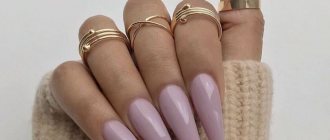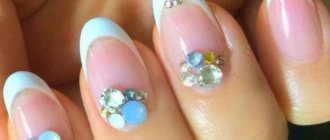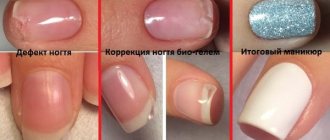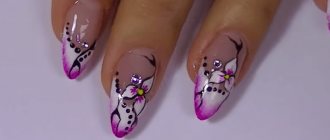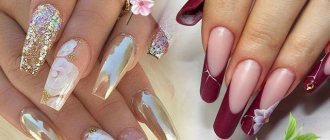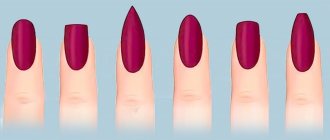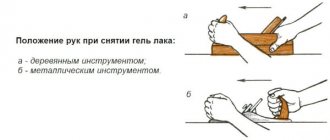The question of whether to extend nails using forms or tips often arises for nail technicians and clients and causes a lot of controversy. Some argue that tips turn out to be stronger in practice, others that this is an outdated method of extension and it is necessary to use forms. There is some truth in both the first and second statements, but this should not be the determining factor in choosing tools for nail extensions. Both tips and forms are only a substrate for modeling materials, and strength is rather determined by their quality and workmanship. Yes, tips, as an extension technology, are much older, but they are still used by masters for a reason. So why is this so and how to choose the right extension method?
A few words about forms and types
Extended nails provide a lot of advantages: manicure lasts much longer on them, they do not break or bend.
Unlike your own, they are perfectly smooth and always the same; you can choose the required length yourself, not limited by physiological factors. In addition, the own plates underneath do not peel off or break. If you want to wear short nails for the sake of fashion, you can also extend them and forget about problems such as an uneven free edge or an unattractive shape of the plate. Several years ago, almost all masters removed work using acrylic from the list of services and left gel extensions on tips or forms. This procedure is relatively inexpensive, takes about 3 hours and requires correction after 3-4 weeks, depending on how quickly your own nails grow.
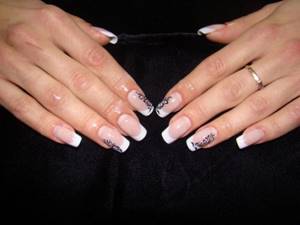
Forms can be disposable from paper and foil or reusable from Teflon. The former are sold in large rolls, the latter must be disinfected every time.
Tips can be transparent or with a pattern already applied, including a French tip. In the latter option, you will have a ready-made jacket on your nails, but as it grows, it will need to be covered. In appearance they are curved, with a slight bend, narrowed or straight. Usually long so that the master can make corrections.
What are forms?

Forms for nail extensions are special templates on which gradations are applied for easy modeling of nails. They are disposable (most often made of paper coated with polymer or metal) and reusable. It is still more practical to use the first ones, since they allow you to more conveniently select a template for various nail shapes. Forms can be top and bottom. I wrote in detail about the first and second and the technology of their use in the article here. But about the detailed technique for performing acrylic and gel extensions on forms, read on the page.
Features of extensions on forms
Here are some facts to help you determine if curve extensions are right for you:
- Working with this technology gives an ideal result in case of an uneven nail plate. The gel fills all irregularities and grooves.
- Makes it possible to lengthen the nail bed itself if the plates are severely bitten.
- More suitable for shaping a free edge rather than lengthening. Therefore, they are almost always chosen for the correction of cracks and fractures.
- It goes faster, although the step-by-step procedures look almost the same.
- Can be used even with very soft nail plates.
- It is a little more difficult to secure it correctly than tips.
- Requires special skill in shaping the direction of nail growth.

It should be noted that this technique is more common among masters.
Gel polish or biogel?
Alisa Patrakeeva, manicurist: “Soluble gel polishes are the newest type of coating. Now there are already a lot of manufacturers of such products, but the most famous among us are Shellac from CND (USA), Gelish from Nail Harmony, Axxium from OPI (USA). All these products are absolutely identical. But they are all called shellac now, just as all cat food is called Whiskas, or all copiers are called Xerox.”

Advantages of gel polish compared to biogel:
• nails look absolutely natural (when using biogel, the nail looks thicker);
• faster to apply and remove;
• does not require sawing off the plate at all (for biogel, the thin top layer is still sawed off);
• protects nails from the effects of household chemicals, nails do not peel off;
• ideal for pedicure (nails look well-groomed for more than a month, without requiring repainting; in addition, it is possible to restore nails on the little toes deformed by shoes).
Advantages of biogel compared to gel polish:
• strengthens the nail much better;
• has more design options.
By the way, the prefix “bio” in the name is just a marketing ploy, and if you still think that “bio” guarantees you some kind of recovery, then you are mistaken.
Source
Nail extension on forms step by step
The forms are a ready-made template, a base on which the modeling material – gel – is laid out. For the extension to be successful and of high quality, you need to follow a simple sequence:
- Remove the gloss from a natural nail using a soft file. At the same time, the cuticle and natural shine are removed, the nail becomes matte. The surface is swept with a large brush.
- The plates are degreased, primer and bonder are applied to them.
- A stand is glued to each nail.
- The gel is applied. The first layer - starting from the cuticle and up to the expected length (with a gap, taking into account the finishing sawdust). Dry in the lamp for 3 minutes. We also apply the second layer sparingly and dry it again. Make sure that the substance is distributed more or less evenly across the entire plate.
- The paper base is removed.
- The sticky layer is removed (including from the inside).
- The sawdust is carried out and the nail is given the required thickness and roundness.
Proper nail filing is a very important part. To be on the safe side, watch the corresponding video at the end of the article on how exactly this is done.
"Overhead" extension
Tips are ready-made plastic overlays of a certain thickness that follow the shape of the nail. They are made of stable elastic material, completely safe for humans. These overlays are glued to the nails on 2/3 of the plate, filed to smooth the transition between the natural nail and the overlay, and covered with the selected material: gel or acrylic. The length can be adjusted at your discretion.
Types can be different:
- in shape - classic, tapered, straight or curved (C-shaped).
- by color - colorless, natural pink or designed (for example, French). You can also choose the degree of transparency.
- according to the area of contact with the natural nail - according to the size of the fit and the thickness of the fit: flat or with recess.
Features of extensions with tips
Features that gel extensions onto tips include:
- When working with this technology, the direction of nail growth is already correctly formed.
- In the stress zone it is necessary to thicken it, since in this case it is more vulnerable. Because of this, the nail may look less natural.
- If the tip is filed very thin, then after applying the gel it can also be compressed quite firmly, forming the correct arch. But if the sawdust is carried out incorrectly, it can easily crack. The sawdust stage is very important in this case.
- Using artificial plates with a pattern already applied, the procedure takes much less time.
- They are sometimes difficult to match to the nail.
- To work with this material, you must have smooth nail plates, otherwise air bubbles will remain between the surfaces.
- After such extensions, nails are more vulnerable to prolonged contact with water.
- It is not advisable to use if your nails are very soft.
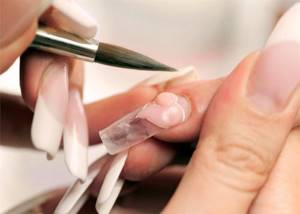
Here is a brief sequence of the process:
- The hands, in particular the cuticle, are treated with a disinfectant, the free edge is shortened and rounded off.
- The shiny layer of the nail is removed.
- The appropriate tip size is selected.
- Apply glue to the step and attach it to the nail (not on the entire surface, but only on the step).
- We carry out sawdust.
- We model the nail with gel.
This is a step-by-step scheme; we can talk endlessly about each specific point, especially about selection and the correct sawdust.
Among these 2 methods there is no clear leader in demand, since both have their own advantages and features.
Advice from experienced manicurists
A novice nail extension artist has plenty of opportunities to learn independently using video tutorials or articles on the Internet. It’s better to take real master classes from professionals. They can share their secrets and valuable information.
Here are some of the tips:
- To create a three-dimensional design, polygel can be mixed with gel polish.
- To avoid detachment, when applying the material must be carefully pressed against the cuticle.
- The impermeable film created by gels, varnishes, and acrylics serves as a breeding ground for bacteria and fungi. Therefore, disinfection is necessary when using decorative coatings.
- You need to file your nails after they are completely dry. A wet nail plate is very vulnerable to mechanical stress and may begin to peel off.
- Nails need to be given periodic rest to recover, and not even use nail polish.
All stages of the process, from nail preparation to extension and design, are similar to techniques for working with gels and gel polishes.
If you have the skill of building extensions with these materials, mastering the use of acrygel will not be difficult.
Little tips for perfect results
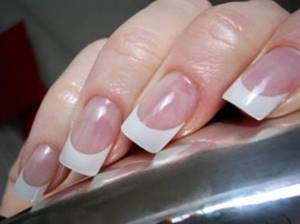
Small nuances that will definitely be useful to you:
- If your nails are too long, do not use scissors or clippers to shorten them. For these purposes, only a special guillotine or coarse abrasive file is suitable.
- After the procedure, use caring oil. Nails are under stress, so for the first 2 days, use this treatment every 3-4 hours.
- It is better to wash your hands thoroughly before applying extensions.
- Inspect the handles for severe scratches, wounds, damage, warts, etc. It is better to cure all inflammatory processes first.
- After the preparation stage, there should be no particles of cut nail tissue left on your hands.
- If you cannot find a tip that fits your nail perfectly, take a wider one and remove the excess with a file.
You can decide which type of extension is right for you together with the specialist or with us. You can see how to correct nails on the pages of the site.
TOP 5 rating according to KP
PNB Clear Pro

The Clear-Pro Nail Forms from PNB are made from super thin, durable, yet ultra flexible vinyl plastic and are suitable for all modeling materials: gel, acrylic and acrylic.
They are resistant to creasing, do not deform or crack, and also have increased adhesiveness and will not fall off at the most crucial moment. Due to the elongated side surfaces, Clear-Pro Nail Forms are very convenient for arch modeling. Special markings for the side rollers are designed for fitting on nails of different widths.
It is also worth noting that vinyl plastic transmits ultraviolet rays well, so even the most capricious, densely pigmented modeling material can be used without a backing, and it dries completely much faster than other forms.
Advantages and disadvantages
Do not deform or crack; suitable for any modeling material
Not very comfortable if the nail plate is too wide
show more
Entity
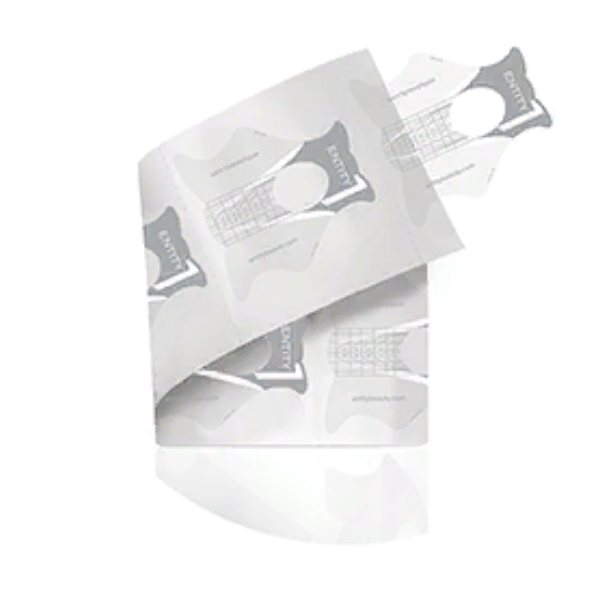
Forms for nail extensions from the American brand Entity are suitable for those who do not like to bother with cutting out forms. The brand produces two types of forms: silver and pink.
Silver ones are traditional in shape, have a standard cutout, are suitable for those who do not have a very pronounced “smile” shape, adhere well and have a comfortable line. The pink shapes have two different sides: on one side there is a flat cut that is ideal for straight eponychium lines, flat, wide or bitten nails. On the other hand, there is a deep neckline; such shapes are suitable for oval nails or with overgrown eponychium.
Advantages and disadvantages
Suitable for a variety of nail shapes, even problematic ones
Not always available for sale
show more
Lunail
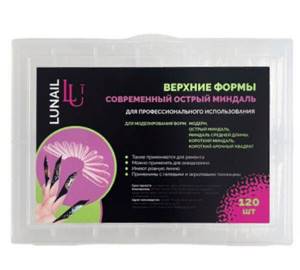
Lunail's reusable plastic molds come in rolls of 120 and 500. They are made of special plastic that is resistant to mechanical and chemical influences during the modeling process, do not deform or break, therefore they allow you to easily create a nail arch without the use of metal tubes.
Convenient markings allow you to cut the shape to fit any shape of the nail plate. Thanks to the “ears,” the forms can be conveniently attached to a finger of any size, and the reinforced central part makes the form stable during nail modeling. It is also worth noting the economical consumption of reusable forms - using 2 forms, you can grow up to 10 nails, even taking into account the “adjustment” to the size.
Advantages and disadvantages
Do not deform or break during modeling; high-quality adhesive base
Not enough glue, may come off during modeling
show more
PINK HOUSE
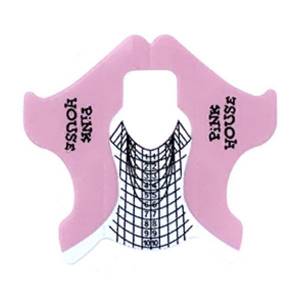
The lower forms for nail extensions from PINK HOUSE are made of pink plastic. They differ from the previous purple and black versions by having a width of 22 mm, which corresponds to the average width of a nail and allows you to work end-to-end.
The forms themselves are translucent, which is very convenient when laying out and distributing the gel, they are evenly and conveniently printed, and most importantly, they have “ears” cut out right away, which saves time. The forms for extensions are quite durable, do not deform, do not wrinkle, and do not peel off, as if adapting to a natural nail. Another difference from other forms is that the packaging is not made in a roll, but in folds of 100 and 300 pieces.
Advantages and disadvantages
No need to trim; thanks to the translucent shade it is easy to lay out modeling material
You can only order on the official website, otherwise there is a risk of getting a fake
show more
Summer

Universal forms for nail extensions are suitable for most types of nails and for modeling with both gel and acrylic. The shapes are easy to press, have a dense solid base, stick together well and do not come apart.
Thanks to convenient markings, the forms are easy to use, and due to their width, they fit both wide nails and nails with high side ridges. The strong adhesive base prevents the form from falling off during modeling, even if your fingers are slightly damp. There are 500 pieces per roll, which means it will last a long time.
Advantages and disadvantages
Suitable for wide nails; do not peel off or peel off
No tear line; may seem too thin
show more
